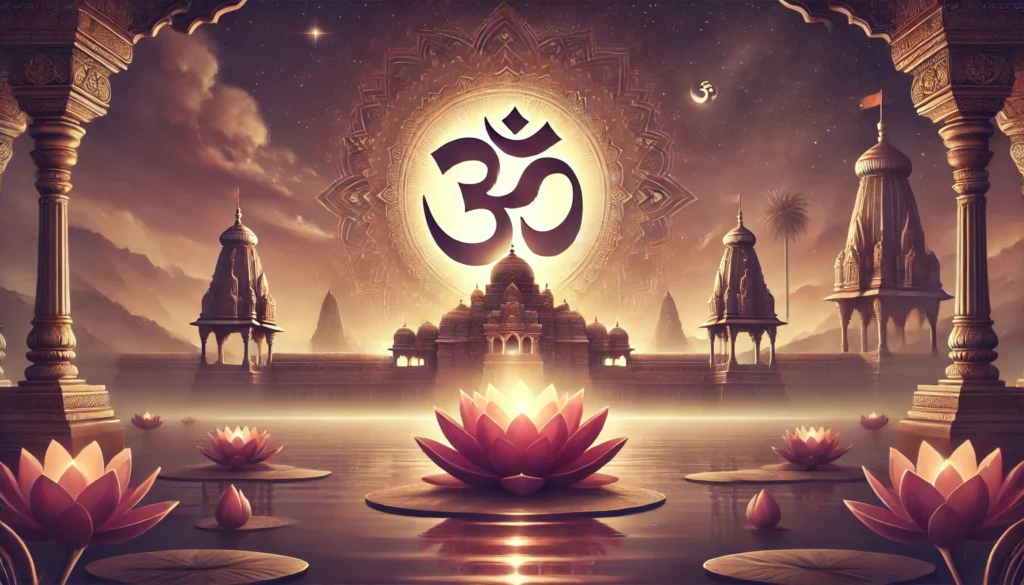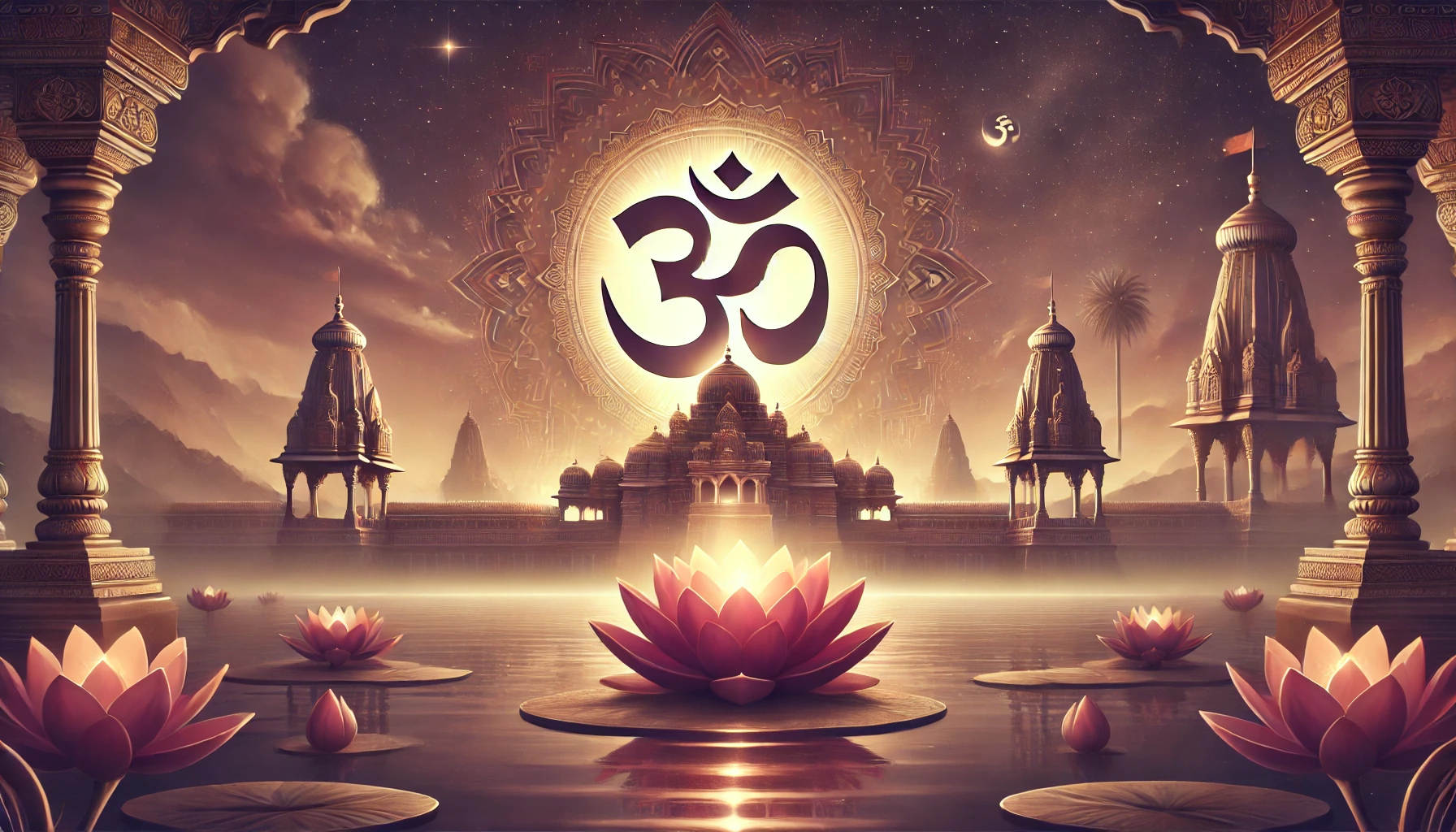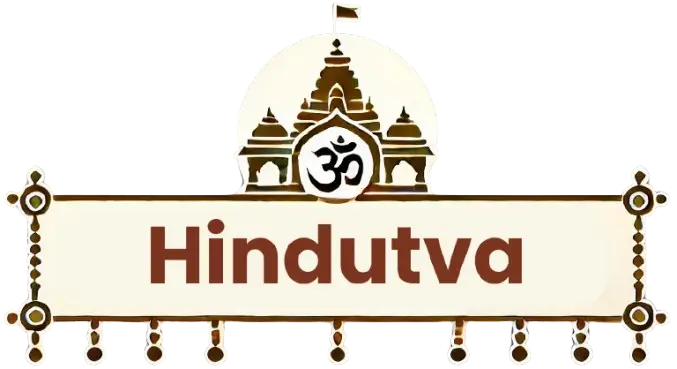Discover the profound significance of Om (ॐ) in Hinduism, exploring its spiritual, scientific, and cultural relevance. Learn how this sacred sound symbolizes creation, enhances meditation, and connects the individual to universal consciousness.
Hinduism is a rich and intricate spiritual tradition, deeply embedded with symbols, rituals, and chants that connect practitioners to the divine. Among these, the symbol and sound of “Om” (ॐ) stand out as the most revered and significant. Om is not just a sound; it is considered the essence of the ultimate reality, the primordial sound that birthed the universe. Its influence permeates meditation, yoga, and spiritual practices, making it an indispensable part of Hindu culture.

The Origin and Meaning of Om
The origins of Om trace back to the Vedas, the oldest sacred texts of Hinduism, written over 3,500 years ago. In these texts, Om is described as the sound of the universe, representing the cosmic vibration from which all existence emerges.
The Mandukya Upanishad, one of the primary Upanishads, elaborates on Om as the essence of all existence. It explains that Om is composed of three sounds – A (ahh), U (ooh), and M (mmm). Together, these phonetic elements signify creation, preservation, and dissolution, representing the trinity of Brahma (the creator), Vishnu (the preserver), and Shiva (the destroyer). When chanted, Om reflects the cycle of life, death, and rebirth, embodying the eternal process of existence.
In addition to the Mandukya Upanishad, the Chandogya Upanishad references Om as the “Udgitha” or the song of the universe. This text explains how priests used Om during sacrificial rituals to invoke divine blessings and purify the space. Such references cement Om’s role not just as a philosophical concept but as a functional tool in religious rites.
Spiritual Significance of Om
In Hinduism, Om is much more than a sound; it is a spiritual icon that connects the individual to higher consciousness. Chanting Om helps in aligning the mind, body, and spirit, fostering peace and tranquility.
Many practitioners believe that chanting Om allows them to experience a direct connection to the divine, facilitating deeper states of meditation. The vibrations produced by Om resonate with the frequencies of nature, harmonizing the body’s energy centers (chakras), particularly the Ajna (third-eye) and Sahasrara (crown) chakras.
Furthermore, Om serves as a reminder of the interconnectedness of all life. The sound transcends linguistic and cultural barriers, embodying the universal truth that everything in existence is part of a singular, divine reality.
The spiritual potency of Om extends to various aspects of Hindu rituals. During temple ceremonies, priests recite Om to sanctify offerings, invoking divine presence. The significance is also evident in personal rituals, where householders chant Om while lighting lamps or beginning new ventures, reinforcing the belief that Om ushers in auspiciousness and wards off negative energies.
Scientific and Psychological Benefits of Chanting Om
Modern science is beginning to uncover the benefits of chanting Om, demonstrating that the practice not only has spiritual but also physiological and psychological advantages.
1. Stress Reduction and Mental Clarity: Studies have shown that chanting Om can significantly reduce stress levels by activating the parasympathetic nervous system. The rhythmic vibration slows the heart rate, calms the mind, and promotes relaxation.
In a 2018 study published in the Journal of Behavioral Medicine, researchers found that participants who chanted Om for ten minutes experienced a measurable decrease in cortisol levels, the hormone responsible for stress.
2. Enhanced Focus and Concentration: Chanting Om during meditation increases alpha waves in the brain, which are associated with calm and focused mental states. This enhances concentration, memory, and cognitive function.
MRI scans conducted during meditation sessions have shown increased activity in brain regions responsible for attention and executive function when participants incorporate Om chanting.
3. Emotional Balance: Regular chanting helps in managing emotions, fostering feelings of compassion, empathy, and connectedness. The vibrations produced stimulate the vagus nerve, which regulates emotional stability and promotes overall well-being.
4. Physical Health: The vibrations of Om improve respiratory function and enhance oxygen flow in the body. This can reduce inflammation, lower blood pressure, and improve overall physical health.
Anecdotal evidence from yoga practitioners reveals that daily Om chanting not only improves lung capacity but also alleviates symptoms of anxiety and depression.
Om in Daily Rituals and Practices
Om is intricately woven into the fabric of Hindu rituals and daily practices. It is chanted at the beginning and end of prayers, recitations, and religious ceremonies. The symbol of Om is often inscribed on temple walls, holy books, and even in homes as a representation of divine energy.
Many people begin their day with the recitation of Om, believing it brings positive energy and spiritual protection. In yoga classes, instructors frequently incorporate Om chanting to center students and establish a meditative atmosphere.
In temples, the sound of bells and conches often accompanies the chanting of Om, creating a powerful spiritual ambiance that is believed to cleanse the space of negative energies.
Om in Yoga and Meditation
Yoga and meditation are two areas where Om plays a crucial role. The sound of Om is often used as a mantra to guide practitioners into deeper states of meditation.
1. Enhancing Meditation: The vibration of Om serves as an anchor, preventing the mind from wandering. It creates a state of mental clarity and tranquility that deepens meditation practices.
2. Activating Chakras: Chanting Om is believed to activate and balance the chakras, facilitating the free flow of energy throughout the body. This can lead to heightened awareness and spiritual awakening.
3. Group Practices: Om is frequently chanted in unison during group meditation or yoga sessions, fostering a sense of unity and collective consciousness.
Symbolism of the Om Symbol (ॐ)
The visual representation of Om holds profound meaning. The symbol consists of three curves, a semicircle, and a dot:
- The large lower curve: Represents the waking state (jagrat).
- The middle curve: Symbolizes the dream state (swapna).
- The upper curve: Denotes the state of deep sleep (sushupti).
- The dot: Represents the transcendental state, the absolute consciousness (turiya).
- The semicircle below the dot: Symbolizes maya (illusion), which prevents one from realizing absolute reality.
Together, the symbol of Om encapsulates the entire cycle of existence, from the physical to the spiritual.
Om Beyond Hinduism
The influence of Om extends beyond Hinduism, resonating in Buddhism, Jainism, and Sikhism. In Buddhism, Om is part of sacred chants like “Om Mani Padme Hum,” a mantra that embodies compassion and enlightenment. Jain texts use Om to signify deep respect and reverence towards enlightened beings.
In modern wellness practices, Om has become a universal symbol of peace and mindfulness, often incorporated into yoga studios, meditation apps, and holistic wellness retreats around the world.
The power of Om lies not just in its sound but in its ability to transform the mind, body, and spirit. As the sound of creation, Om connects practitioners to the universal consciousness, promoting inner peace, spiritual growth, and holistic well-being. By integrating Om into daily practices, one can unlock a deeper understanding of the self and the cosmos.
Author:
Sandeep Vohra – Philosopher & Vedic Scholar

